At least 5 CMEs heading toward Earth, G4 – Severe or Greater Geomagnetic Storm Watch in effect for May 11
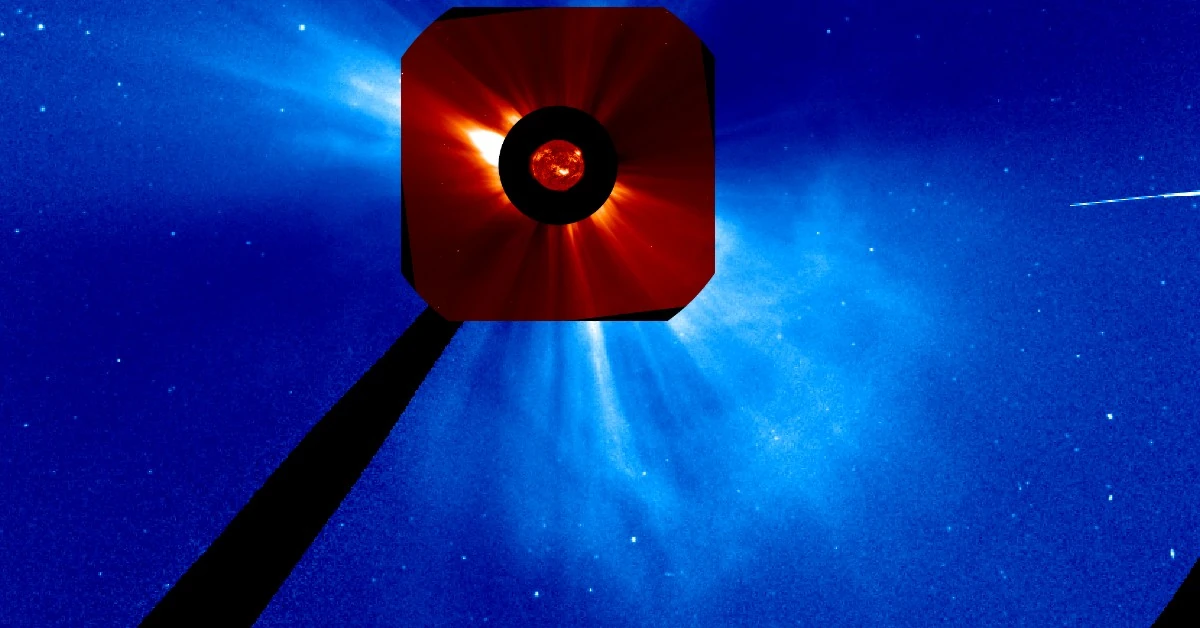
At least five coronal mass ejections (CMEs) produced over the past 3 days are heading toward Earth. The first impact is expected on May 9 and the following over the next 3 – 4 days.
- At least 5 CMEs will impact Earth from May 9 – 13
- G4 – Severe or Greater Geomagnetic Storm Watch is in effect for May 11
- An X2.2 solar flare erupted during the writing of this report. A strong CME was produced and is likely Earth-directed
“It’s a solar storm train! We now have FIVE storms headed towards Earth,” said space weather physicist, Dr. Tamitha Skov on May 9.
“Storms 2, 3, and 5 will be direct hits as seen in the coronagraph imagery. Impacts start around midday May 10 and will continue through late May 12 at least. G3-level conditions and extended aurora aurora is possible.”
It's a #solarstorm train! We now have FIVE storms headed towards Earth! Storm 2, 3, and 5 will be direct hits as seen in the coronagraph imagery. Impacts start around midday May 10 and will continue through late May 12 at least. G3-level conditions & extended #aurora possible. pic.twitter.com/7OZihcJ0xG
— Dr. Tamitha Skov (@TamithaSkov) May 9, 2024
A Triple Play! Back-to-back #solarstorm direct hits chase a third storm to Earth. First impact begins midday May 10. NOAA models show the direct hits should arrive by early May 11. Expect #aurora chances well into mid-latitudes. G2+ conditions possible. Expect #GPS, #HF radio… pic.twitter.com/imJzt3SCfd
— Dr. Tamitha Skov (@TamithaSkov) May 8, 2024
EXCITING TIME! Several possibly Earth-directed CMEs. This video shows LASCO C2 images side by side with GOES X-ray light curves. Note the frames starting 02:48 UT on May 7, 05:36, 12:24, and 22:36 UT on May 8. The near-Earth space environment will be messy during May 10-13. pic.twitter.com/Uz6hM3Mgx0
— Halo CME (@halocme) May 9, 2024
Updated geomagnetic storm forecast (May 10, 12:38 UTC):
As a result of very high solar activity from May 6 through 9, a G4 – Severe or Greater Geomagnetic Storm Watch is in effect for May 11. Due to continued high levels of activity and Earth-directed CMEs, we might even see G5 – Extreme levels, or at least prolonged G4 – Severe periods in the days ahead.
Only three G4 – Severe geomagnetic storms have been observed during this solar cycle (SC25) which began in December 2019.
The last G4 – Severe storm was on March 23, 2024, and the last G5 – Extreme was the Halloween Storm in October 2003. That G5 resulted in power outages in Sweden and damaged power transformers in South Africa.
According to the SWPC update at 12:30 UTC on May 10, periods of active conditions and G1 – Minor storming are likely on May 10 with the possible early arrival of a series of CMEs (from May 8 to 10).
The bulk of the incoming CMEs is expected to arrive early on May 11 (UTC) with periods of G1 – Minor to G2 – Moderate geomagnetic storming expected, and periods of G3 – Strong to G4 – Severe storms likely.
Periods of G1 – Minor to G2 – Moderate storms are likely on May 12 due to an enhanced solar wind environment following the passage of the May 8 – 10 CMEs.
*** end of update ***
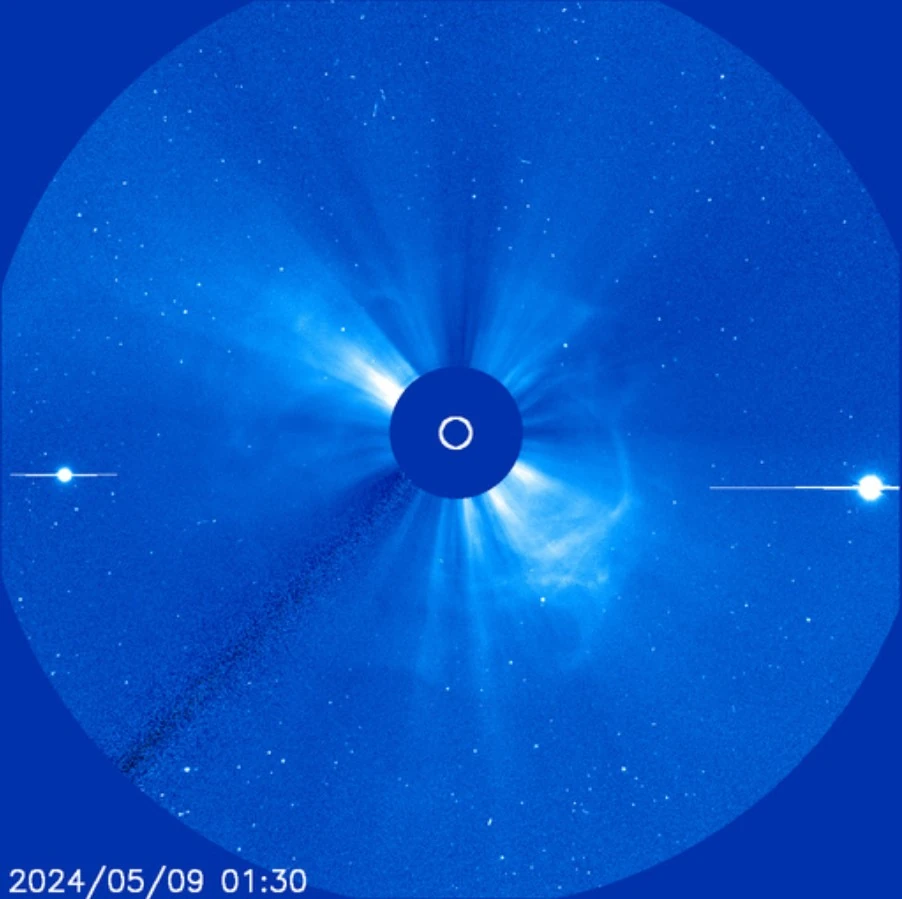

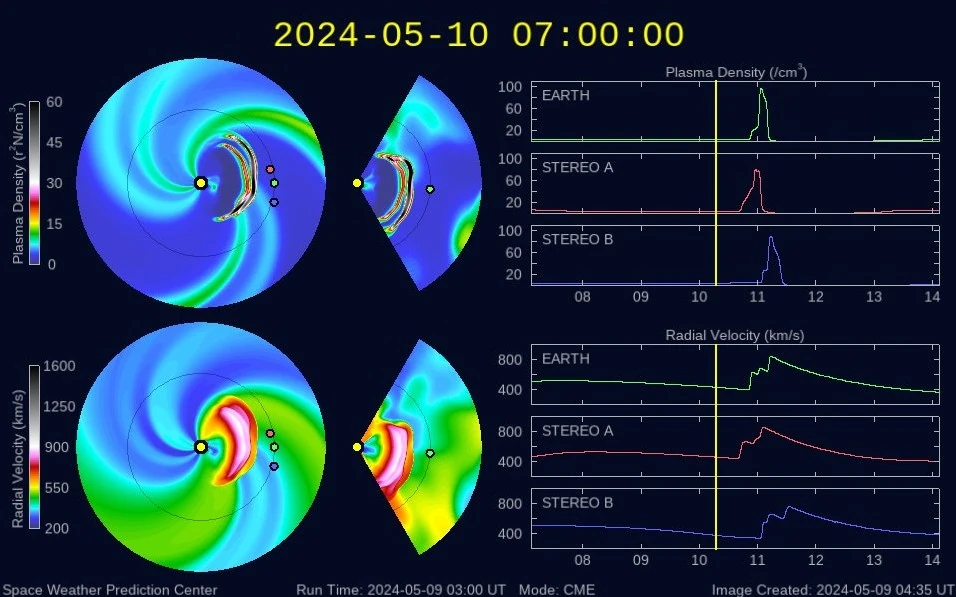

The Sun has been extremely active since the beginning of the month, producing more than 50 M-class flares — some of them very close to X-class, and 8 X-class flares —the strongest of which was X4.5 on May 6.
The latest was X2.2 at 09:13 UTC on May 9 from Region 3664. This event was associated with a Type IV and Type II Radio Emission (with an estimated velocity of 1 004 km/s) — suggesting a strong CME was produced. LASCO coronagraph imagery is still not available for this event, but there is a very good chance this one will have parts of it heading our way, too.
| Max class | Time (UTC) |
|---|---|
| X2.2 | 05/9, 09:13 |
| M2.1 | 05/9, 08:40 |
| M2.4 | 05/9, 06:27 |
| M2.3 | 05/9, 06:13 |
| M1.7 | 05/9, 04:49 |
| M4.5 | 05/9, 03:32 |
| M4.0 | 05/9, 03:17 |
| X1.0 | 05/8, 21:40 |
| M1.7 | 05/8, 20:34 |
| M2.0 | 05/8, 19:21 |
| M2.9 | 05/8, 18:36 |
| M7.9 | 05/8, 17:53 |
| M8.6 | 05/8, 12:04 |
| M4.1 | 05/8, 11:22 |
| M2.1 | 05/8, 09:48 |
| M1.8 | 05/8, 09:37 |
| M4.5 | 05/8, 07:41 |
| M7.1 | 05/8, 06:53 |
| X1.0 | 05/8, 05:09 |
| M3.5 | 05/8, 04:30 |
| M1.9 | 05/8, 03:42 |
| M1.8 | 05/8, 03:27 |
| M3.4 | 05/8, 02:27 |
| X1.0 | 05/8, 01:41 |
| M8.2 | 05/7, 16:30 |
| M1.0 | 05/7, 13:35 |
| M1.0 | 05/7, 13:25 |
| M1.5 | 05/7, 12:54 |
| M2.4 | 05/7, 11:50 |
| M1.3 | 05/7, 08:23 |
| M5.1 | 05/7, 06:16 |
| M2.6 | 05/7, 00:58 |
| M4.3 | 05/6, 22:27 |
| M1.2 | 05/6, 21:48 |
| M1.5 | 05/6, 09:59 |
| X4.5 | 05/6, 06:35 |
| M1.3 | 05/6, 05:28 |
| M1.6 | 05/6, 01:06 |
| M1.3 | 05/5, 19:52 |
| M1.0 | 05/5, 18:40 |
| M1.3 | 05/5, 17:01 |
| M2.2 | 05/5, 15:38 |
| M1.3 | 05/5, 14:47 |
| X1.2 | 05/5, 11:54 |
| M7.4 | 05/5, 10:00 |
| M2.3 | 05/5, 09:38 |
| M1.3 | 05/5, 08:19 |
| X1.3 | 05/5, 06:01 |
| M8.4 | 05/5, 01:27 |
| M9.0 | 05/4, 23:48 |
| M3.2 | 05/4, 22:37 |
| M1.3 | 05/4, 18:20 |
| M1.5 | 05/4, 07:07 |
| M9.1 | 05/4, 06:19 |
| M1.6 | 05/4, 00:36 |
| M2.4 | 05/3, 23:30 |
| M1.0 | 05/3, 23:16 |
| M1.2 | 05/3, 22:47 |
| M4.4 | 05/3, 08:11 |
| X1.6 | 05/3, 02:22 |
| M2.7 | 05/3, 00:15 |
| M2.7 | 05/2, 20:57 |
| M1.0 | 05/2, 02:17 |
| M1.8 | 05/1, 22:31 |
| M1.9 | 05/1, 14:44 |
| M1.8 | 05/1, 14:32 |
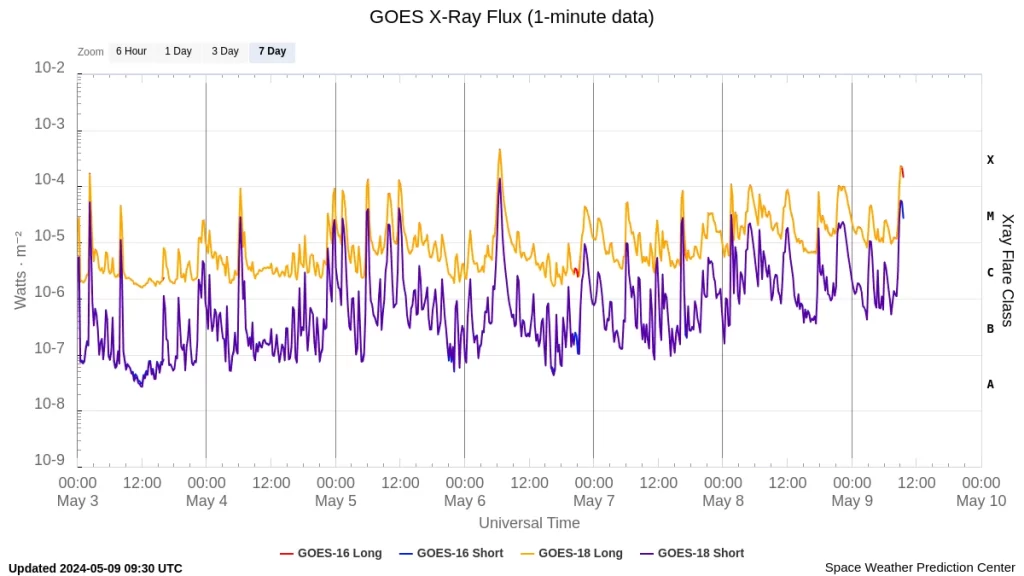

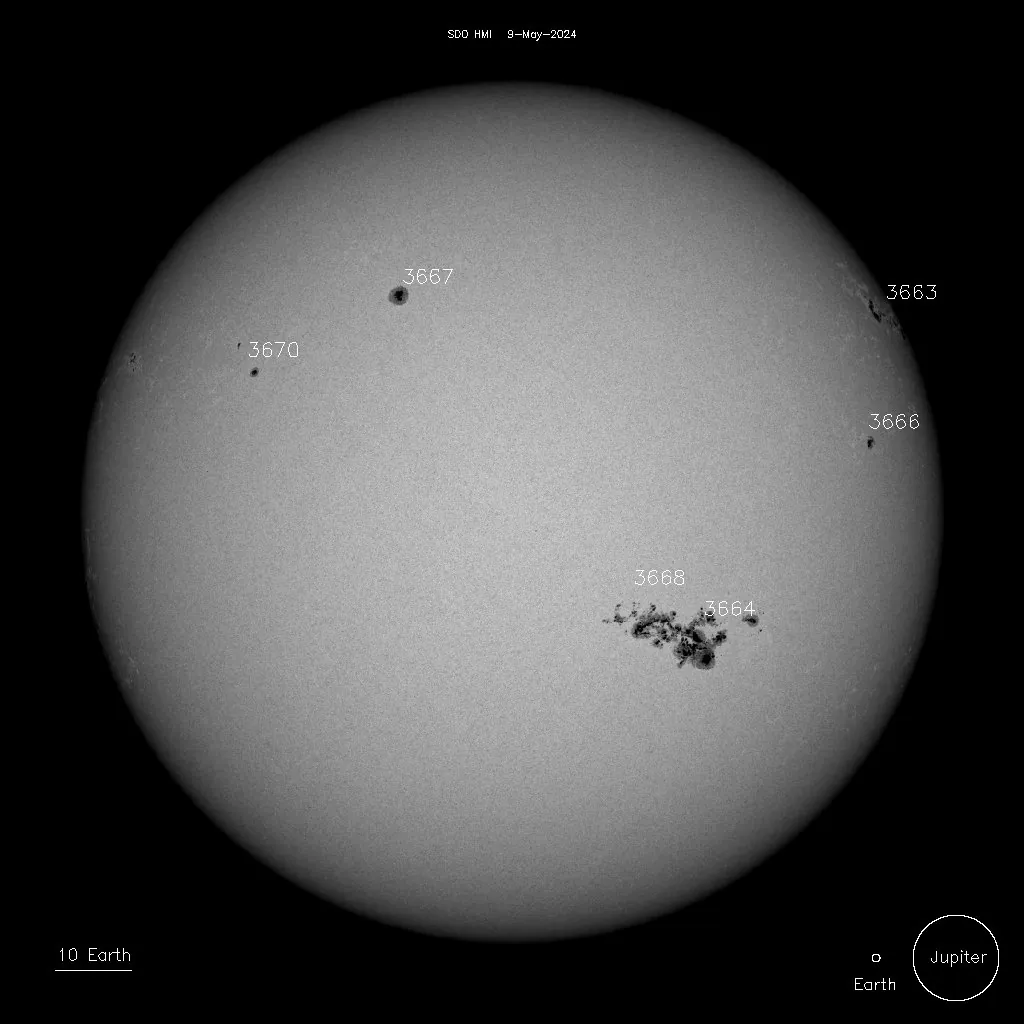

Solar activity is expected to persist at high to very high levels through May 11, with M-class flares (95%) expected and X-class flares (60%) likely, due to the continued flare potential of Region 3663 and especially Region 3664 (beta-gamma-delta).
Updates
18:43 UTC, May 10
The first CME impacted Earth at 16:56 UTC on May 10. The geomagnetic field responded with a G1 – Minor storm by 17:14 UTC. From then it quickly escalated to G3 – Strong by 17:18 UTC and to G4 – Severe geomagnetic storm by 17:44 UTC.
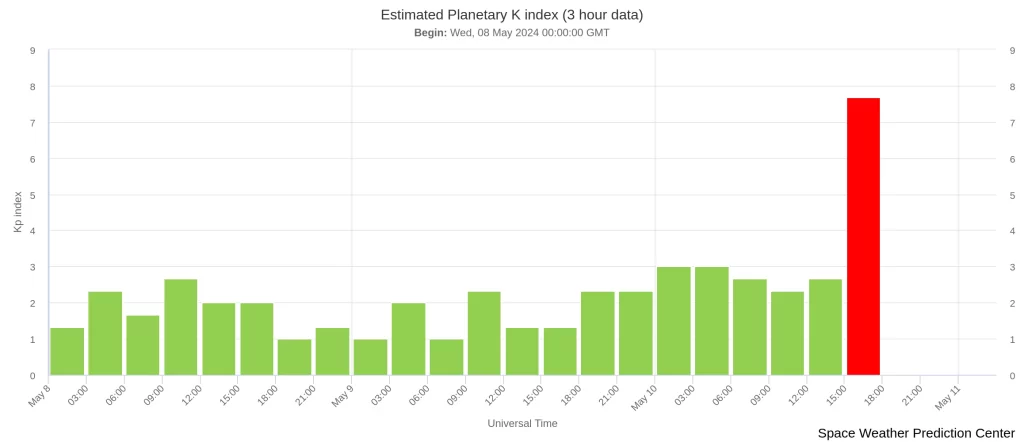

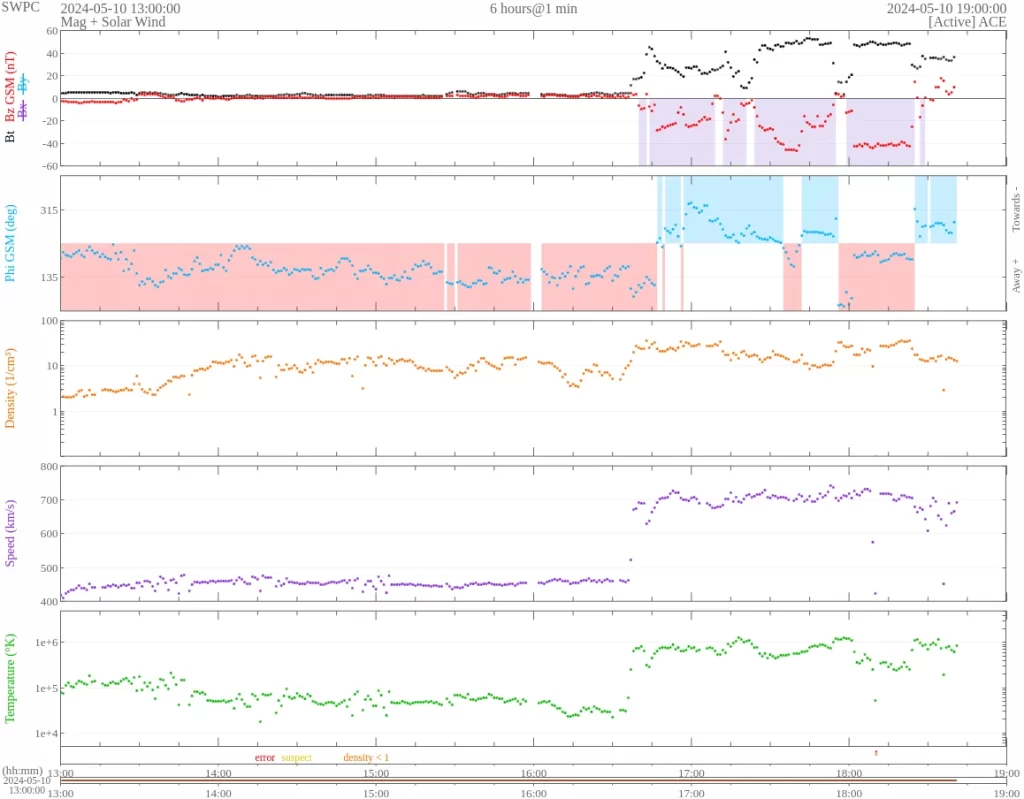

Proton flux started rising after 07:00 UTC on May 9 due to increased flare activity from Region 3664 and reached the S1 – Minor solar radiation storm threshold at 13:55 UTC on May 10.
As activity in this region continued, with numerous M- and several X-class flares, proton flux levels kept rising and reached S2 – Moderate levels at 17:46 UTC.
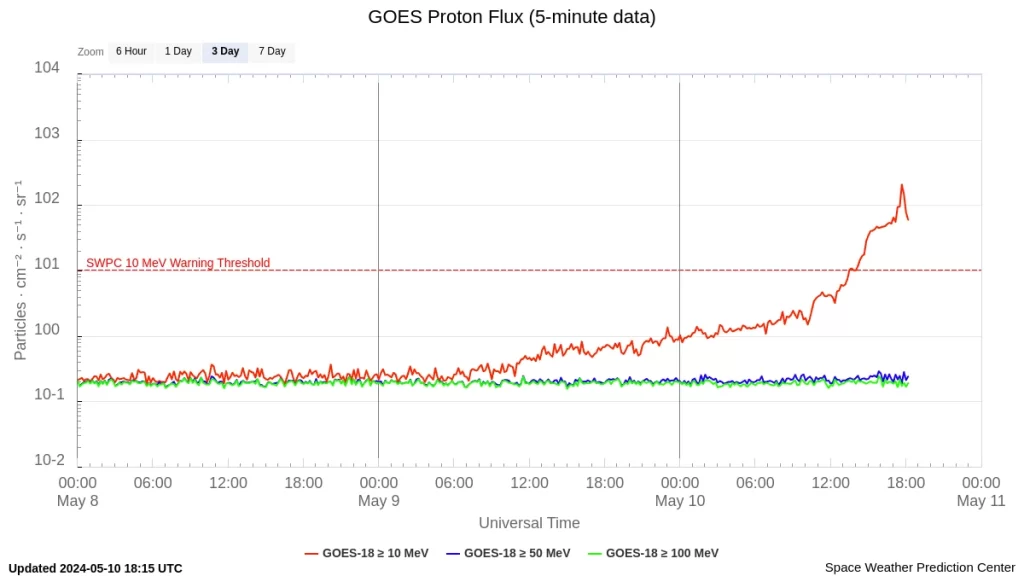

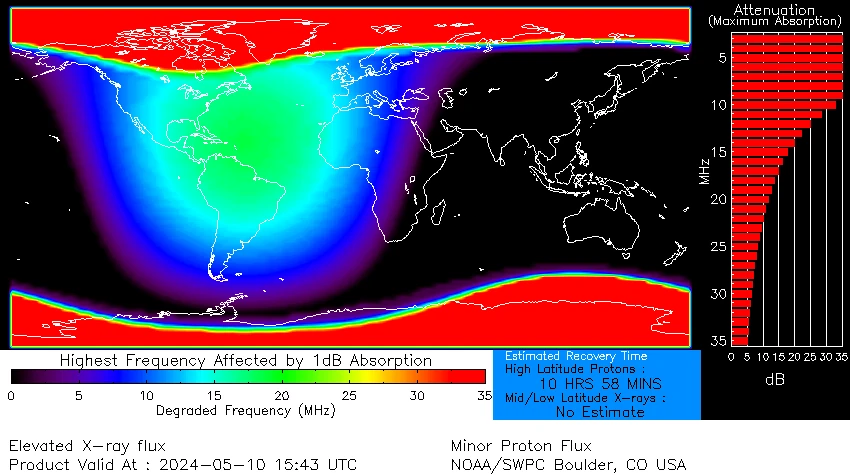

04:14 UTC, May 11
G5 – Extreme geomagnetic storm threshold was reached at 23:34 UTC.
Under G5 conditions, the area of impact is primarily poleward of 40 degrees Geomagnetic Latitude.
Widespread voltage control and protective system issues can occur in power systems, with some grid networks possibly facing complete collapse or blackouts. Transformers may suffer damage due to electrical stress.
Spacecraft operations may encounter significant surface charging, leading to problems with orientation, uplink/downlink communication, and satellite tracking.
In other systems, pipeline currents can surge to hundreds of amps, potentially causing infrastructure damage. High-frequency (HF) radio propagation might become impossible in many regions for up to two days, while satellite navigation could face degradation for several days. Low-frequency radio navigation may also be disrupted for hours. Auroras might be visible as far south as Florida and southern Texas, around 40° geomagnetic latitude.
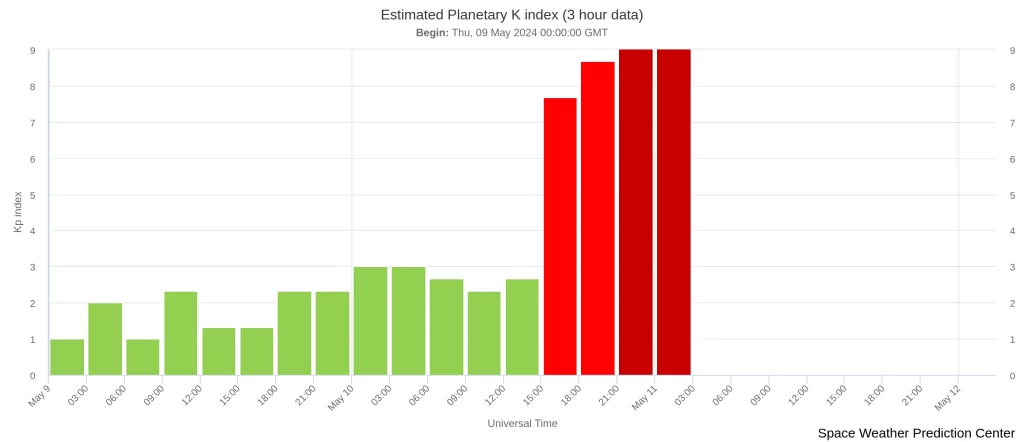

Periods of G3 – Strong to G5 – Severe geomagnetic storms are expected on May 11 due to continued CME activity.
Featured image credit: NASA/ESA LASCO, Helioviewer, The Watchers. Acquired at 10:58 UTC on May 8, 2024


So do the solar flares affect our weather? Would seem likely, as they emit energy, clashing with other molecules, etc. I don’t believe in climate change, (ie typical “definition”), but I would believe that the sun storms are greatly changing our climate.